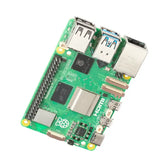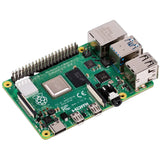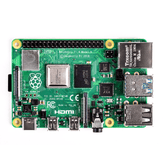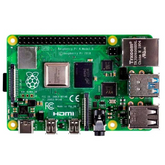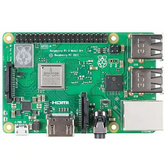Raspberry Pi for AI and Machine Learning
Summary
Explore the dynamic intersection of Raspberry Pi, AI, and Machine Learning in our latest blog. Delve into the essentials with "Understanding Machine Learning" and seamlessly kickstart your journey by "Getting Started with Raspberry Pi and AI." Uncover the intricacies of machine learning algorithms, set up a robust environment, and embark on hands-on experiences like training models on Raspberry Pi. Learn how to implement AI applications, understand the advantages, and navigate limitations. Peek into the future of AI innovations with Raspberry Pi. Don't miss the conclusion for a tantalizing glimpse into the boundless possibilities ahead! Start your AI adventure now.
Introduction
Artificial Intelligence (AI) and Machine Learning have evolved into transformative technologies with widespread applications across diverse industries. AI, encompassing machine learning, is the driving force behind innovations like self-driving cars and intelligent virtual assistants. This chapter delves into the fundamental concepts of these technologies and their pivotal role in shaping the future.
The significance of Machine Learning and AI extends far beyond theoretical applications. Industries such as healthcare, finance, and manufacturing have witnessed remarkable advancements, streamlining processes and improving decision-making. Understanding the real-world impact of these technologies is crucial for appreciating their potential contributions to different sectors.
Browse the Best Selection of Raspberry Pi Boards.
Role of Raspberry Pi in AI Exploration
Raspberry Pi, a credit card-sized computer, emerges as a key player in democratizing AI exploration. Its affordability and versatility make it an ideal platform for enthusiasts and professionals alike. This section explores how Raspberry Pi serves as a gateway to hands-on experimentation with AI and Machine Learning, providing a practical and accessible avenue for learning and innovation.

Understanding Machine Learning
Machine Learning, a subset of Artificial Intelligence, involves the development of algorithms that enable systems to learn and improve from experience. The scope of Machine Learning spans vast applications, from predicting user preferences to optimizing complex industrial processes.
Types of Machine Learning Algorithms
- Supervised Learning: In supervised learning, algorithms learn from labeled datasets, making predictions or decisions based on input data. This section explores the precision and applicability of supervised learning in various domains.
- Unsupervised Learning: Unsupervised learning involves training algorithms on unlabeled data, allowing them to discover patterns independently. Understanding the versatility of unsupervised learning is crucial for harnessing its potential in data exploration and clustering.
- Reinforcement Learning: Reinforcement learning focuses on training models to make sequences of decisions by receiving feedback in the form of rewards or penalties. This subsection delves into real-world examples where reinforcement learning has demonstrated remarkable success.

Applications of Machine Learning and AI
Machine Learning and AI find applications across diverse sectors, revolutionizing how tasks are accomplished. From healthcare diagnostics to fraud detection in finance, this section explores the myriad ways these technologies enhance efficiency and decision-making.
Getting Started with Raspberry Pi and AI
Raspberry Pi, a compact and versatile single-board computer, serves as a powerhouse for AI enthusiasts and developers. This section introduces the fundamental capabilities and components of Raspberry Pi, laying the groundwork for AI exploration.
Selecting the appropriate Raspberry Pi model is crucial for optimizing AI projects. This subsection provides insights into the various models available, highlighting their specifications and use cases to aid in informed decision-making.
Efficient installation of the operating system is a pivotal step in setting up Raspberry Pi for AI endeavors. This section guides users through the installation process, ensuring a seamless and stable foundation for subsequent AI framework installations.
Harnessing the full potential of Raspberry Pi in AI requires the integration of specialized frameworks and libraries. Explore this subsection for a step-by-step guide on setting up AI tools, enhancing the capabilities of your Raspberry Pi for machine learning tasks.
Unlocking the true potential of AI on Raspberry Pi involves leveraging accelerators. Delve into this section to understand the significance of AI accelerators and how to access and integrate them, optimizing the performance of your Raspberry Pi for AI workloads.
Embarking on the AI journey with Raspberry Pi becomes more accessible through hands-on projects and tutorials. This subsection provides a curated list of engaging projects, allowing users to apply their newfound knowledge and skills in real-world AI applications.

Understanding the Basics of Machine Learning
Machine Learning (ML) is the heartbeat of Artificial Intelligence (AI), fueling its ability to learn and adapt. In this section, we delve into the essence of ML, exploring how it forms the core of AI applications and revolutionizes problem-solving.
Supervised Learning stands as a cornerstone in ML methodologies. Uncover the intricacies of this approach, understanding how it utilizes labeled datasets to train models and its wide-ranging applications across industries.
Contrary to its supervised counterpart, Unsupervised Learning operates without predefined labels. This segment demystifies Unsupervised Learning, focusing on clustering techniques that enable machines to identify patterns without explicit guidance.
Embark on a journey into Reinforcement Learning, a paradigm where agents learn through trial and error. Real-world examples illuminate the application of Reinforcement Learning, showcasing its role in decision-making and autonomous systems.
Choosing the right tools is paramount in the ML landscape. Navigate through the diverse programming languages and frameworks that empower ML development, ensuring your projects are built on a robust foundation.
Discover the symbiotic relationship between Raspberry Pi and ML. Unearth why Raspberry Pi emerges as an ideal platform for ML enthusiasts, offering a cost-effective and accessible environment for developing and deploying machine learning models.
Exploring Different Machine Learning Algorithms
Machine Learning Algorithms form the backbone of intelligent systems, enabling them to decipher patterns and make informed decisions. In this section, we unravel the diverse world of ML algorithms, understanding their pivotal role in the AI landscape.

Linear Regression
Linear Regression, a fundamental algorithm, sets the stage for predictive modeling. Dive into the simplicity and effectiveness of linear regression, exploring its applications in forecasting and understanding relationships within data.
Decision Trees and Their Versatility
Decision Trees are the architects of decision-making processes in ML. Uncover the versatility of these hierarchical structures, decoding how they navigate complex choices and find applications in classification and regression tasks.
The Power of Random Forests
Random Forests emerge as a force to be reckoned with in ML ensemble methods. Discover how this collection of decision trees enhances predictive accuracy, mitigates overfitting, and becomes a go-to solution for various applications.
Support Vector Machines (SVM)
Support Vector Machines carve a niche in the ML realm by defining clear decision boundaries. Explore the elegance of SVM, understanding its applications in classification and regression tasks, especially in scenarios with complex data distributions.
Neural Networks and Their Applications
Neural Networks emulate the human brain, paving the way for deep learning. Unearth the layers of artificial neurons, grasp the applications of neural networks in image recognition, natural language processing, and beyond.
Guidelines for Choosing the Right Algorithm
Amidst the algorithmic landscape, the choice of the right tool is paramount. Delve into guidelines that aid in selecting the most fitting ML algorithm for a given task, ensuring optimal performance and results.
Setting up a Machine Learning Environment on Raspberry Pi
In the rapidly evolving landscape of technology, the integration of machine learning has become imperative across diverse industries. Understand the pivotal role ML plays in enhancing processes, driving innovation, and fostering efficiency.
Selecting the optimal Raspberry Pi model is a critical decision in establishing a robust machine learning environment. Explore the specifications and capabilities of different models, aligning them with the computational requirements of your AI projects.
The foundation of any ML setup on Raspberry Pi begins with the installation of a suitable operating system. Navigate through the installation process, ensuring compatibility and optimizing the environment for AI exploration.
Fine-tune the Raspberry Pi environment for optimal performance. Dive into configuration settings, optimizing parameters to create a stable and efficient platform for machine learning experimentation.
The arsenal of machine learning is incomplete without the right set of libraries. Learn the step-by-step process of installing essential ML libraries on your Raspberry Pi, empowering it with the tools necessary for AI development. ### 6.6. Optimizing Models for Raspberry Pi As the hardware resources on Raspberry Pi differ from traditional setups, discover strategies for model optimization. Uncover techniques to streamline models, ensuring they run seamlessly on the Raspberry Pi architecture.
Explore the option of leveraging more powerful machines for initial model training. Understand the nuances of training models on high-performance systems before deploying them on the resource-constrained Raspberry Pi.
In the era of cloud computing, explore alternatives for offloading intensive tasks. Delve into cloud-based solutions, understanding how they complement Raspberry Pi setups and enhance the scalability of AI applications.

Training a Machine Learning Model on Raspberry Pi
Before diving into model training, ensure your Raspberry Pi is well-prepared. Check for necessary updates, optimize settings, and confirm that all components are functioning seamlessly to create a stable foundation for the training process.
The success of any machine learning model hinges on the quality of the dataset used for training. Explore methodologies for selecting diverse, representative datasets that align with the objectives of your AI project on the Raspberry Pi.
Efficient preprocessing is the key to refining raw data into a format suitable for training. Learn the art of feature engineering, where you transform and enhance variables to extract valuable insights, laying the groundwork for effective model training.
The choice of the machine learning algorithm significantly impacts the model's performance. Delve into considerations for selecting the most appropriate algorithm based on your dataset and the specific goals of your Raspberry Pi-powered AI project.
Given the resource constraints of Raspberry Pi, optimization is crucial during the training phase. Explore techniques to streamline model training, making it resource-efficient without compromising the quality of the learning process.
Uncover the potential of hardware acceleration to expedite model training on Raspberry Pi. Understand how accelerators enhance computational capabilities, allowing for more complex models and faster iterations in the training pipeline.
Implementing AI Applications with Raspberry Pi
Discover the seamless integration of artificial intelligence (AI) into diverse industries using Raspberry Pi. Explore real-world applications where AI brings tangible benefits, enhancing efficiency, and driving innovation.
Uncover the vast possibilities that arise when implementing AI on the compact and versatile Raspberry Pi platform. From edge computing to IoT applications, delve into the potential of deploying AI for various tasks.
As you venture into implementing AI on Raspberry Pi, understand the nuances of deploying custom architectures. Explore considerations related to model complexity, resource utilization, and the unique challenges posed by the Raspberry Pi environment.
Achieving real-time performance is paramount in many AI applications. Delve into optimization strategies tailored for Raspberry Pi, ensuring your AI models run efficiently and deliver timely results, even in resource-constrained scenarios.

Advantages and Limitations of Machine Learning on Raspberry Pi
Advantages of Utilizing Raspberry Pi for Machine Learning
Raspberry Pi, with its compact form factor and cost-effectiveness, presents numerous advantages for machine learning enthusiasts and professionals alike:
- Affordability: Raspberry Pi offers an affordable entry point for experimenting with machine learning, making it accessible to a broader audience.
- Power Efficiency: With lower power consumption compared to traditional computing systems, Raspberry Pi aligns with energy-efficient practices, ideal for sustainable AI projects.
- Community Support: The extensive Raspberry Pi community provides a wealth of knowledge, tutorials, and resources, fostering collaborative learning and troubleshooting.
- Educational Tool: Raspberry Pi serves as an excellent educational tool, enabling students and learners to explore machine learning concepts hands-on.
Limitations and Challenges Faced with Raspberry Pi
While Raspberry Pi offers unique advantages, it also comes with certain limitations and challenges:
- Computational Power: Due to its compact design, Raspberry Pi may have limitations in handling resource-intensive machine learning tasks that demand substantial computational power.
- Memory Constraints: Limited RAM on Raspberry Pi may constrain the size of datasets and the complexity of machine learning models that can be effectively processed.
- Hardware Acceleration: While GPU support is available in some models, the absence of dedicated hardware accelerators for machine learning can impact performance.
- Scalability: Scaling machine learning projects may be challenging on Raspberry Pi, especially when dealing with large-scale datasets or distributed computing.
Understanding these advantages and limitations is crucial for making informed decisions when selecting Raspberry Pi for machine learning endeavors.
Future Possibilities and Innovations in AI with Raspberry Pi
Emerging Trends in AI and Machine Learning
As we look towards the future, the landscape of artificial intelligence (AI) and machine learning (ML) on Raspberry Pi is poised for exciting developments. Several emerging trends are shaping the trajectory of these technologies:
- Edge AI Dominance: The integration of AI directly on edge devices like Raspberry Pi is gaining prominence. This shift reduces dependency on cloud resources and enhances real-time processing capabilities.
- Federated Learning: Raspberry Pi's decentralized nature makes it an ideal candidate for federated learning—a collaborative approach where models are trained across multiple devices without exchanging raw data.
- Explainable AI: With an increased focus on ethical AI, the demand for models that offer transparency and interpretability is growing. Future projects on Raspberry Pi are likely to emphasize explainable AI methodologies.
Potential Innovations and Developments with Raspberry Pi
In the realm of AI and ML on Raspberry Pi, the future holds immense potential for innovative projects and advancements:
- Custom Hardware Accelerators: The development of specialized hardware accelerators for AI workloads on Raspberry Pi could significantly enhance computational efficiency.
- Advanced Neural Network Architectures: As AI algorithms evolve, Raspberry Pi is expected to support more advanced neural network architectures, enabling sophisticated applications in image recognition, natural language processing, and more.
- IoT Integration: The intersection of AI and the Internet of Things (IoT) on Raspberry Pi is likely to result in smarter and more autonomous IoT devices, contributing to the growth of intelligent and connected ecosystems.
The dynamic landscape of AI and ML, coupled with Raspberry Pi's versatility, suggests a future filled with innovative applications and widespread integration into various domains. As developers continue to push boundaries, thepotential for groundbreaking projects on Raspberry Pi remains limitless.
Conclusion
As we draw the curtain on this comprehensive journey through the realms of machine learning (ML), artificial intelligence (AI), and their integration with Raspberry Pi, it's crucial to recap some key learnings.
- Versatility of Raspberry Pi: Throughout our exploration, we witnessed how Raspberry Pi, with its compact size and affordability, emerges as a versatile platform for AI and ML projects. Its adaptability spans various industries and applications.
- Diverse Machine Learning Landscape: The landscape of machine learning is vast, encompassing diverse algorithms and methodologies. Understanding the basics and exploring different algorithms equips enthusiasts to make informed choices for their projects.
Our exploration merely scratches the surface of the immense possibilities within AI and ML, especially when combined with the power of Raspberry Pi. Encouraging further exploration is not just a suggestion; it's a call to action. The landscape is ever-evolving, and new innovations await those who delve deeper. To our readers and aspiring AI enthusiasts, consider this conclusion not as an endpoint but as a launchpad. The future of AI and ML on Raspberry Pi is brimming with opportunities for innovation, creativity, and problem-solving. Embrace the challenges, stay curious, and let your journey into the world of AI and Raspberry Pi be a continuous quest for knowledge and groundbreaking applications.



